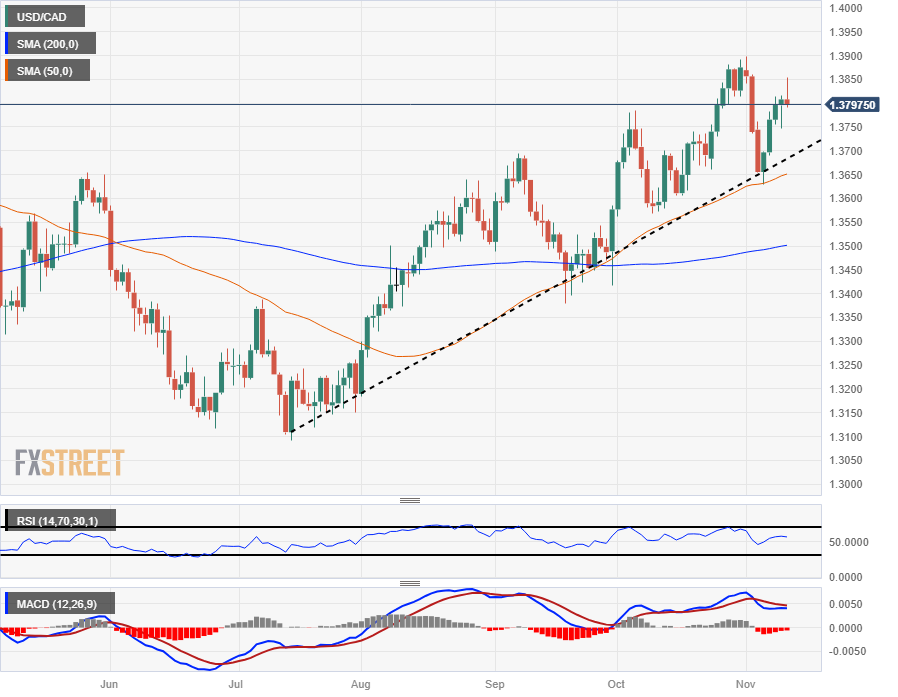Canadian Dollar holds steady on Friday supported by rebounding Crude Oil
- The Canadian Dollar has seen little but downside this week.
- A pivot to market Fed expectations is sending investors into the US Dollar.
- Crude Oil bids try to recover, limiting Loonie losses for Friday.
The Canadian Dollar (CAD) is in the red overall for the week, seeing only a minor gain on Friday, closing the last trading day of the week up a whole five pips against the US Dollar (USD).
Canada has seen a thin showing on the economic calendar all week, and next week is set for more of the same as broader markets focus on the US Dollar and investors get pushed around by central bank expectations.
Daily Digest Market Movers: Canadian Dollar recedes as traders pick the Greenback
- The CAD is trying to reverse a week of losses, shedding 1.5% against the USD.
- Risk aversion appears to be the general tone to overall market themes, sending the USD higher across the board.
- US Michigan Consumer Sentiment Index for November dropped back to 60.4 from 63.8.
- UoM 5-Year Consumer Inflation Expectations ticked up from 3% to 3.2%.
- Federal Reserve Chairman Jerome Powell’s hawkish showing yesterday continues to bleed through markets as investors prove jittery around inflation.
- Crude Oil is seeing soft gains for Friday, helping to support the Loonie and limit CAD losses.
- Next Tuesday sees US Consumer Price Index (CPI) inflation figures that should electrify Greenback traders.
Technical Analysis: Canadian Dollar drops to 1.3850 against US Dollar
The USD/CAD has climbed 1.65% bottom-to-top this week, sending the Greenback-Loonie pair into familiar highs and etching in a Friday peak of 1.3850.
The pair kicked off the week’s trading with a clean bounce from the 50-day Simple Moving Average (SMA) near 1.3630, and the week’s price action has been notably one-sided the entire way through.
Monday’s low-side rebound also saw a rejection from a rising trendline from July’s swing low into the 1.3100 region.
The near-term ceiling for USD/CAD bulls to beat will be the 1.3900 handle, a technical barrier that rejected the pair at the beginning of the month.
USD/CAD Daily Chart

Canadian Dollar FAQs
What key factors drive the Canadian Dollar?
The key factors driving the Canadian Dollar (CAD) are the level of interest rates set by the Bank of Canada (BoC), the price of Oil, Canada’s largest export, the health of its economy, inflation and the Trade Balance, which is the difference between the value of Canada’s exports versus its imports. Other factors include market sentiment – whether investors are taking on more risky assets (risk-on) or seeking safe-havens (risk-off) – with risk-on being CAD-positive. As its largest trading partner, the health of the US economy is also a key factor influencing the Canadian Dollar.
How do the decisions of the Bank of Canada impact the Canadian Dollar?
The Bank of Canada (BoC) has a significant influence on the Canadian Dollar by setting the level of interest rates that banks can lend to one another. This influences the level of interest rates for everyone. The main goal of the BoC is to maintain inflation at 1-3% by adjusting interest rates up or down. Relatively higher interest rates tend to be positive for the CAD. The Bank of Canada can also use quantitative easing and tightening to influence credit conditions, with the former CAD-negative and the latter CAD-positive.
How does the price of Oil impact the Canadian Dollar?
The price of Oil is a key factor impacting the value of the Canadian Dollar. Petroleum is Canada’s biggest export, so Oil price tends to have an immediate impact on the CAD value. Generally, if Oil price rises CAD also goes up, as aggregate demand for the currency increases. The opposite is the case if the price of Oil falls. Higher Oil prices also tend to result in a greater likelihood of a positive Trade Balance, which is also supportive of the CAD.
How does inflation data impact the value of the Canadian Dollar?
While inflation had always traditionally been thought of as a negative factor for a currency since it lowers the value of money, the opposite has actually been the case in modern times with the relaxation of cross-border capital controls. Higher inflation tends to lead central banks to put up interest rates which attracts more capital inflows from global investors seeking a lucrative place to keep their money. This increases demand for the local currency, which in Canada’s case is the Canadian Dollar.
How does economic data influence the value of the Canadian Dollar?
Macroeconomic data releases gauge the health of the economy and can have an impact on the Canadian Dollar. Indicators such as GDP, Manufacturing and Services PMIs, employment, and consumer sentiment surveys can all influence the direction of the CAD. A strong economy is good for the Canadian Dollar. Not only does it attract more foreign investment but it may encourage the Bank of Canada to put up interest rates, leading to a stronger currency. If economic data is weak, however, the CAD is likely to fall.